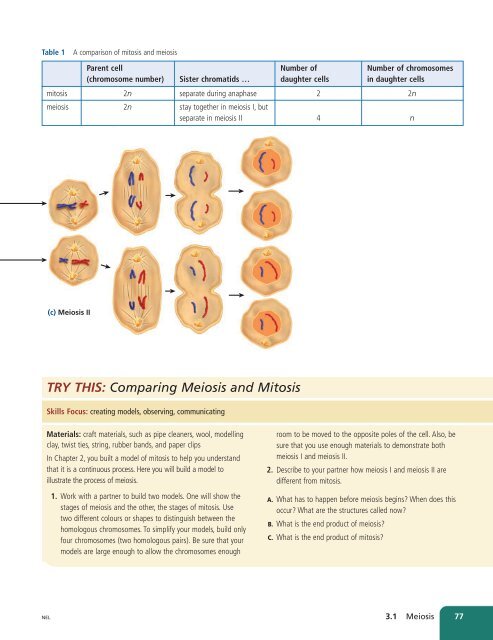Unit A Reproduction
Unit A Reproduction
Unit A Reproduction
You also want an ePaper? Increase the reach of your titles
YUMPU automatically turns print PDFs into web optimized ePapers that Google loves.
Table 1<br />
A comparison of mitosis and meiosis<br />
Parent cell Number of Number of chromosomes<br />
(chromosome number) Sister chromatids … daughter cells in daughter cells<br />
mitosis 2n separate during anaphase 2 2n<br />
meiosis 2n stay together in meiosis I, but<br />
separate in meiosis II 4 n<br />
(c) Meiosis II<br />
TRY THIS: Comparing Meiosis and Mitosis<br />
Skills Focus: creating models, observing, communicating<br />
Materials: craft materials, such as pipe cleaners, wool, modelling<br />
clay, twist ties, string, rubber bands, and paper clips<br />
In Chapter 2, you built a model of mitosis to help you understand<br />
that it is a continuous process. Here you will build a model to<br />
illustrate the process of meiosis.<br />
1. Work with a partner to build two models. One will show the<br />
stages of meiosis and the other, the stages of mitosis. Use<br />
two different colours or shapes to distinguish between the<br />
homologous chromosomes. To simplify your models, build only<br />
four chromosomes (two homologous pairs). Be sure that your<br />
models are large enough to allow the chromosomes enough<br />
room to be moved to the opposite poles of the cell. Also, be<br />
sure that you use enough materials to demonstrate both<br />
meiosis I and meiosis II.<br />
2. Describe to your partner how meiosis I and meiosis II are<br />
different from mitosis.<br />
A. What has to happen before meiosis begins? When does this<br />
occur? What are the structures called now?<br />
B. What is the end product of meiosis?<br />
C. What is the end product of mitosis?<br />
NEL<br />
3.1 Meiosis 77

















